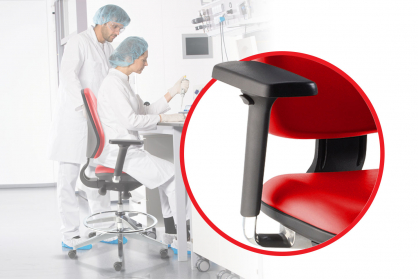Blog
One-dimensional armrests can offer a simple and effective solution for enhancing user well-being and task efficiency in laboratory settings, especially when integrated thoughtfully into the overall design of the workstation. Avaialble exclusively on our MVMT™ line models, their benefits are maximized when they are part of a holistic approach to ergonomics, including workspace design, user habits, and organizational practices.
Task-Related Benefits
- Consistent Support: One-dimensional (1D) armrests provide constant support for the forearms and elbows, which can be beneficial for tasks that require prolonged periods of stability, such as microscopy, pipetting or extensive keyboarding. This consistent level of support helps in maintaining a steady hand, which is crucial for precision work.
- Simplified Design for Specific Tasks: In workspaces where tasks are highly specialized and the workstation setup does not require frequent adjustments, 1D armrests can be designed to meet the specific needs of those tasks. This can eliminate the potential for distractions caused by more complicated adjustable features, allowing users to focus on the task at hand.
Ergonomic Benefits
- Promotion of Neutral Posture: 1D armrests can still be designed to promote a neutral posture for the user. By supporting the elbows and forearms, they reduce the strain on the shoulders, neck, and back, which is essential in helping prevent musculoskeletal discomfort and injuries.
- Reduction in Shoulder and Neck Strain: 1D armrests that are designed and positioned appropriately can help in reducing strain on the shoulders and neck by providing a place to rest the arms. This can be particularly beneficial in tasks that do not require extensive arm movement, allowing the muscles to relax periodically.
- Increased Comfort Over Short Durations: For tasks that are performed over shorter periods, 1D armrests can offer sufficient support and comfort. They provide a fixed point of support that can help in reducing fatigue and discomfort, allowing the user to focus on their work without constant adjustments.
Implementation Considerations
To maximize the benefits of 1D armrests in a laboratory setting, several considerations should be taken into account:
- Ergonomic Assessment: It's important to conduct an ergonomic assessment of the workstation and tasks to ensure that the static armrests are positioned at a height and distance that provide optimal support for the majority of users.
- Supplement with Adjustable Components: While the armrests themselves may be one dimensional, other components of the workstation, such as the chair height or worksurface, can be adjustable to accommodate different body sizes and tasks.
- Regular Breaks and Movement: Encouraging regular breaks and movement can help offset the limitations of static armrests, ensuring that users do not remain in one position for too long, which can lead to discomfort and health issues.
Let’s determine if 1D armrests are right for your workplace.
